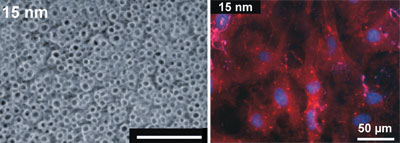| Posted: July 2, 2009 |
Stem cells show size-specific reaction to nanopatterns |
|
(Nanowerk News) Scientists in Germany have found that surface topography can be more important than chemistry for stem cells (Size selective behavior of mesenchymal stem cells on ZrO2 and TiO2 nanotube arrays – free access article).
|
 |
| Mesenchymal stem cells proliferate (right) on 15nm-diameter zirconium oxide nanotubes
|
|
Patrik Schmuki of the Frederich-Alexander University of Erlangen-Nuremberg, and colleagues looked at how stem cells behave on nanotube-coated surfaces and found that they show a size-specific reaction to the nanopatterns. The researchers propose that nanopatterned surfaces could have potential applications in tissue engineering and in medical implants, such as replacement hips. Schmuki suggests that decorating implant surfaces with patterns on a similar scale to cells (around 10 micrometres) may improve the implant's integration into the body.
|
|
Surface patterns on the microscale are already known to influence cell growth and activity, but little is known about the sub-100nm range, explains Schmuki. He and his team created patterns of titanium and zirconium oxide nanotubes (oxides widely used for implant surfaces) of differing heights. They then modified clinically relevant cells - mesenchymal stem cells, which can differentiate into bone-forming cells called osteoblasts - to express a green fluorescent protein. The researchers could then watch the cells interact with the nanopatterns using fluorescence microscopy. They found that the cell density on the surface depended on the nanotubes' diameter but not their length or chemistry.
|
|
|
|
Matthew Dalby from the University of Glasgow, UK, an expert on stem cell responses to nanoscale surfaces, sees the importance of the results. 'This is a question of topography versus chemistry,' he says, 'and [this work] shows that topography is winning!' Dalby adds that he would now like to see how the surfaces affect activity such as cell differentiation.
|
|
Schmuki agrees that differentiation studies are an important next step. He is also planning to extend the work to hematopoietic stem cells - cells that give rise to blood cells - and would like to investigate nanotube surfaces as potential drug and biomolecule delivery systems.
|

